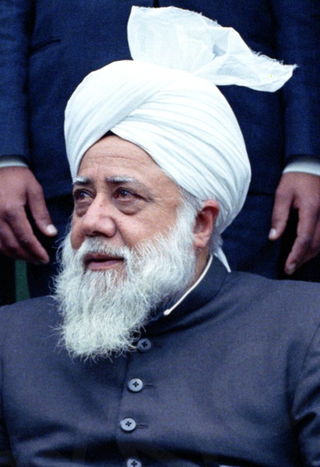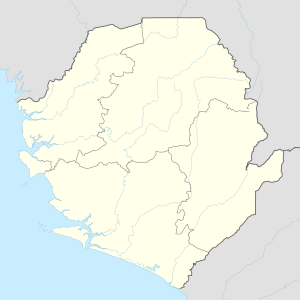
Mirza Nasir Ahmad was the third Caliph of the Ahmadiyya Muslim Community from Pakistan. He was elected as the third successor of Mirza Ghulam Ahmad on 8 November 1965, the day after the death of his predecessor and father, Mirza Basheer-ud-Din Mahmood Ahmad.

Mirza Basheer-ud-Din Mahmood Ahmad was the second caliph, leader of the worldwide Ahmadiyya Muslim Community and the eldest son of Mirza Ghulam Ahmad from his second wife, Nusrat Jahan Begum. He was elected as the second successor of Mirza Ghulam Ahmad on 14 March 1914 at the age of 25, the day after the death of his predecessor Hakim Nur-ud-Din.

The Fazl Mosque also known as The London Mosque, is the first purpose-built mosque in London, England. It was opened on 23 October 1926 in Southfields, Wandsworth. At a cost of £6,223, the construction of the mosque and the purchase of the land on which it stands, was financed by the donations of Ahmadi Muslim women in Qadian, Punjab, British India, with support from the British Muslim convert Khalid Sheldrake. Between 1984 and 2019 the Fazl Mosque was the residence of the caliphs of the Ahmadiyya Muslim Community, and therefore its de facto international headquarters. The administrative headquarters now lies at the site of the Islamabad, Tilford.

Ahmadiyya is an Islamic branch in Switzerland, under the spiritual leadership of the caliph in London. The Community was founded on October 13, 1946, during the late period of the Second Caliphate, when the caliph directed Shaikh Nasir Ahmad to establish a mission in the country. Today there are two Ahmadi mosques and 14 local branches, representing an estimated 800 Ahmadi Muslims.

Ahmadiyya, officially the Ahmadiyya Muslim Jama'at (AMJ) is an Islamic messianic movement originating in British India in the late 19th century. It was founded by Mirza Ghulam Ahmad (1835–1908), who said he had been divinely appointed as both the Promised Mahdi and Messiah expected by Muslims to appear towards the end times and bring about, by peaceful means, the final triumph of Islam; as well as to embody, in this capacity, the expected eschatological figure of other major religious traditions. Adherents of the Ahmadiyya—a term adopted expressly in reference to Muhammad's alternative name Aḥmad—are known as Ahmadi Muslims or simply Ahmadis.

Ahmadiyya is an Islamic branch in Indonesia. The earliest history of the community in Indonesia dates back to the early days of the Second Caliph. During the summer of 1925, roughly two decades prior to the Indonesian revolution, a missionary of the Community, Rahmat Ali, stepped on Indonesia's largest island Sumatra. He established the movement with 13 devotees in Tapaktuan, in the province of Aceh. The Community has an influential history in Indonesia's religious development,. However, in the modern times it has faced increasing intolerance from religious establishments in the country and physical hostilities from radical Muslim groups. The Association of Religion Data Archives estimates around 400,000 Ahmadi Muslims, spread over 542 branches across the country.

Ahmadiyya is a minority religion in Bangladesh. Although the first Bengalis to join the religion did covert during the lifetime of Mirza Ghulam Ahmad, the religion was first established as a community in the region of Bengal in 1913 by Syed Muhammad Abdul Wahed, during the Caliphate of Hakeem Noor-ud-Din. As the worldwide community is itself is an highly organised group under the Caliph, the national community works under the name Ahmadiyya Muslim Community Bangladesh or Ahmadiyya Muslim Jama'at Bangladesh. There are an estimated 100,000 Ahmadis in the country as of 2004.

Jāmi’ah al-Ahmadīyyah is an International Islamic seminary and educational institute with campuses in Pakistan, United Kingdom, India, Ghana, Canada, Germany, Nigeria, Indonesia, Bangladesh, Malaysia, Tanzania, Sri Lanka, Sierra Leone, and Kenya. In addition, there are affiliated Mu'alameen centers in Pakistan and Madagascar. Founded in 1906 as a Section in Madrassa Talim ul Islam by Mirza Ghulam Ahmad of Qadian, the founder of the Ahmadiyya Muslim Community, it is the main centre of the Ahmadiyya Muslim Community for Islamic learning.

The Ahmadiyya Muslim Community was established in United Kingdom was established in July 1913 as one of the oldest Islamic associations in the UK. The community has built its presence with the establishment of significant sites such as The London Mosque in 1926. Over the decades the community has grown and become known for its annual convention the Jalsa Salana, interfaith dialogues and humanitarian efforts. The UK has also served as the headquarters of the community since 1984 currently in Islamabad, Tilford, in Surrey.

Ahmadiyya is an Islamic branch in the United States. The earliest contact between the American people and the Ahmadiyya movement in Islam was during the lifetime of Mirza Ghulam Ahmad. In 1911, during the era of the First Caliphate of the Community, the Ahmadiyya movement in India began to prepare for its mission to the United States. However, it was not until 1920, during the era of the Second Caliphate of the Ahmadiyya movement, that Mufti Muhammad Sadiq, under the directive of the caliph, would leave England on SS Haverford for the United States. Sadiq established the Ahmadiyya Muslim Community in the United States in 1920. The U.S. Ahmadiyya movement is considered by some historians as one of the precursors to the Civil Rights Movement in America. The Community was the most influential Muslim community in African-American Islam until the 1950s. Today, there are approximately 15,000 to 20,000 American Ahmadi Muslims spread across the country.

Ahmadiyya is an Islamic branch in Spain, under the spiritual leadership of the caliph in London. The earliest history of the Community in Spain dates back to the period of the Second Caliph, when Malik Mohammad Sharid Gujrati, a missionary of the Community, arrived in Madrid on March 10, 1936. However, in the same year the Spanish Civil War broke out forcing Gujrati to abandon the country. Missionary efforts commenced once again following the Second World War, in 1946 when Karam Ilahi Zafar was sent by the caliph. The Basharat Mosque in Pedro Abad, built by the Ahmadiyya in the 1980s is the first mosque to be built in Spain since the Fall of Granada and the end of Muslim rule at the end of the 15th century. Today there are two purpose-built Ahmadi Muslim mosques and roughly 500 adherents in Spain.

Ahmadiyya in The Gambia is part of the worldwide Ahmadiyya Muslim Jama'at under the leadership of the Ahmadiyya Caliphate. Ahmadiyya teachings entered Gambia during the era of the Second Caliphate through the flow of Ahmadiyya literature and a number of traders returning to the country. The first missionary to enter the country was Alhaji Hamza Sanyaolo, a Nigerian who entered in 1959. After a number of months he was followed by Gibriel Saeed, a Ghanaian missionary. Since its earliest history in the Gambia, the community has been facing resistance and religious intolerance from certain Muslim clerics and Islamic bodies in the country.

Ahmadiyya is an Islamic community in Japan. The history of the Ahmadiyya Muslim Community in Japan begins after a number of mentions by Mirza Ghulam Ahmad, who showed a particular interest in introducing Islam to the Japanese people. The first Ahmadi Muslim missionary to be sent to Japan was Sufi Abdul Qadeer, who was sent by the second Caliph. He arrived in Japan on June 4, 1935. Today there is one purpose-built mosque, the largest in the country, representing an estimated 300 Ahmadi Muslims.

The Ahmadiyya Muslim Community is the second largest group of Islam in Ghana after Sunni Islam. The early rise of the Community in Ghana can be traced through a sequence of events beginning roughly at the same time as the birth of the Ahmadiyya movement in 1889 in British India. It was during the early period of the Second Caliphate that the first missionary, Abdul Rahim Nayyar was sent to what was then the Gold Coast in 1921 upon invitation from Sunni Muslims in Saltpond. Having established the movement in the country, Nayyar left and was replaced by the first permanent missionary, Al Hajj Fadl-ul-Rahman Hakim in 1922.

Ahmadiyya is a community in Ireland under the spiritual leadership of the caliph in London. The Community was formally registered in the country in 1992, during the era of the Fourth Caliphate. Today there are two Ahmadiyya mosques in the country, one of which is purpose-built, representing up to 500 Ahmadis in the country.

Ahmadiyya is an Islamic movement in Australia, first formally founded in the country in the 1980s, during the era of the fourth caliph. However, the history of the Community dates back to the early 20th century, during the lifetime of the founder of the movement, Mirza Ghulam Ahmad, with the first contacts arising as a consequence of Australians travelling to British India, and also as a consequence of early, "Afghan" camel drivers settling in Australia during the mid to late 19th century. Today there are at least four Ahmadi mosques in four of the six Australian states, representing an estimated 6,000-8,000 Australian Ahmadis in the country.

Ahmadiyya is an Islamic religious movement in Liberia. Founded in the year 1956, during the era of the Second Caliphate, the movement today represents an estimated 10% of the country's Muslim population. Approximately, this corresponds to 30,000 Ahmadi Muslims in Liberia. Current National President is Maulvi Naveed Ahmad Aadil.

Ahmadiyya is an Islamic religious community in Singapore. The Community was established during the era of the Second Caliphate, shortly before the Second World War. Ghulam Hussain Ayyaz was the first missionary sent to the region, who under the direction of the caliph, arrived in 1935, in a period when the territory was part of the Straits Settlements. In the 1970s, the Community had roughly 200 followers, represented by 1-2% of the Muslim population.

Al-Hajj Abdul Rahim Nayyar was a companion of Mirza Ghulam Ahmad and a missionary of the Ahmadiyya Islamic movement in West Africa. He pledged allegiance to Ghulam Ahmad, formally joining the Ahmadiyya movement, in 1901. Travelling to the Gold Coast in 1921 upon invitation from Muslims in Saltpond, Nayyar was instrumental in consolidating Ahmadiyya missions in several West African countries.

Ahmadiyya is an Islamic branch in Nigeria under the caliph in London. Members of the organization are predominantly from Western Nigeria.









